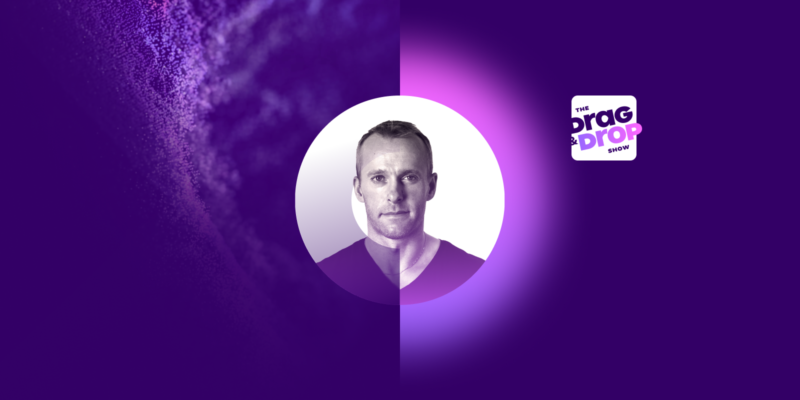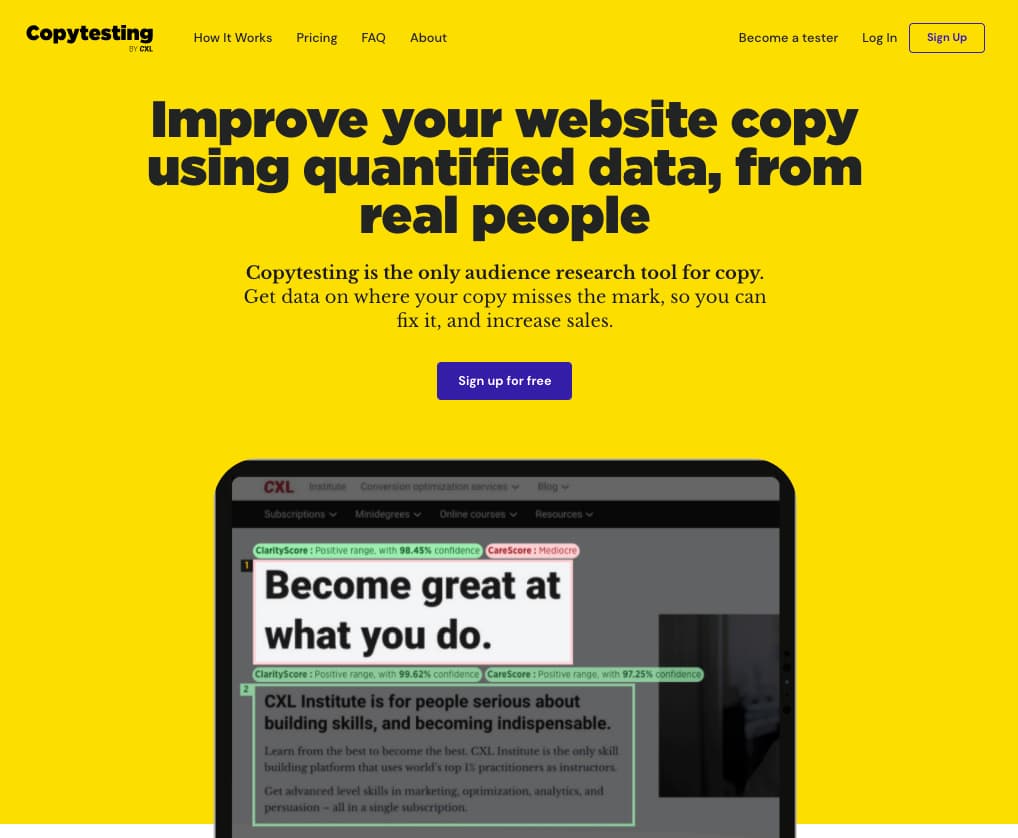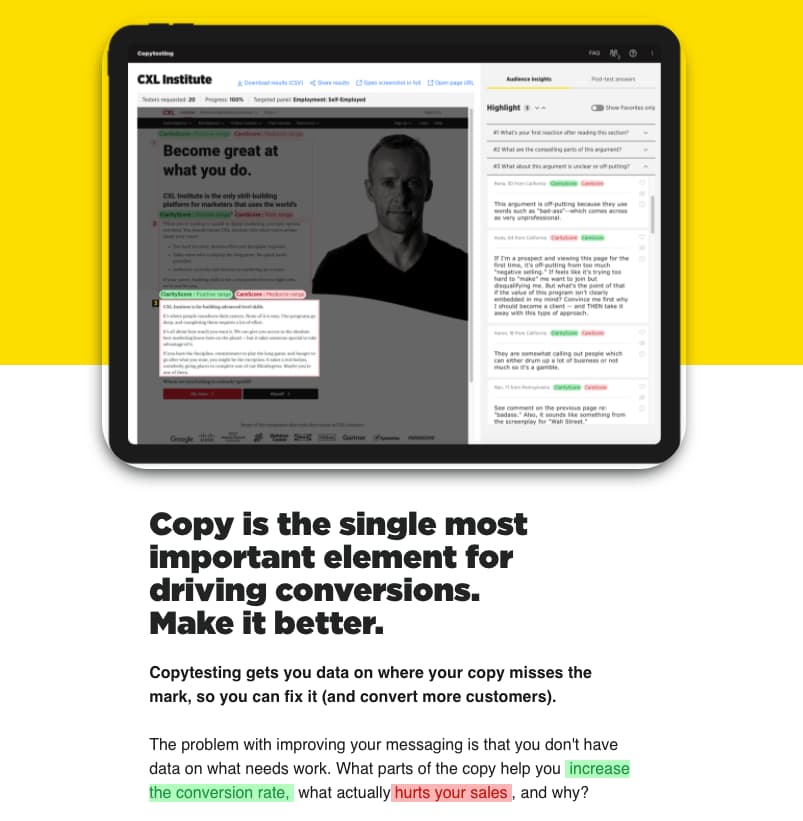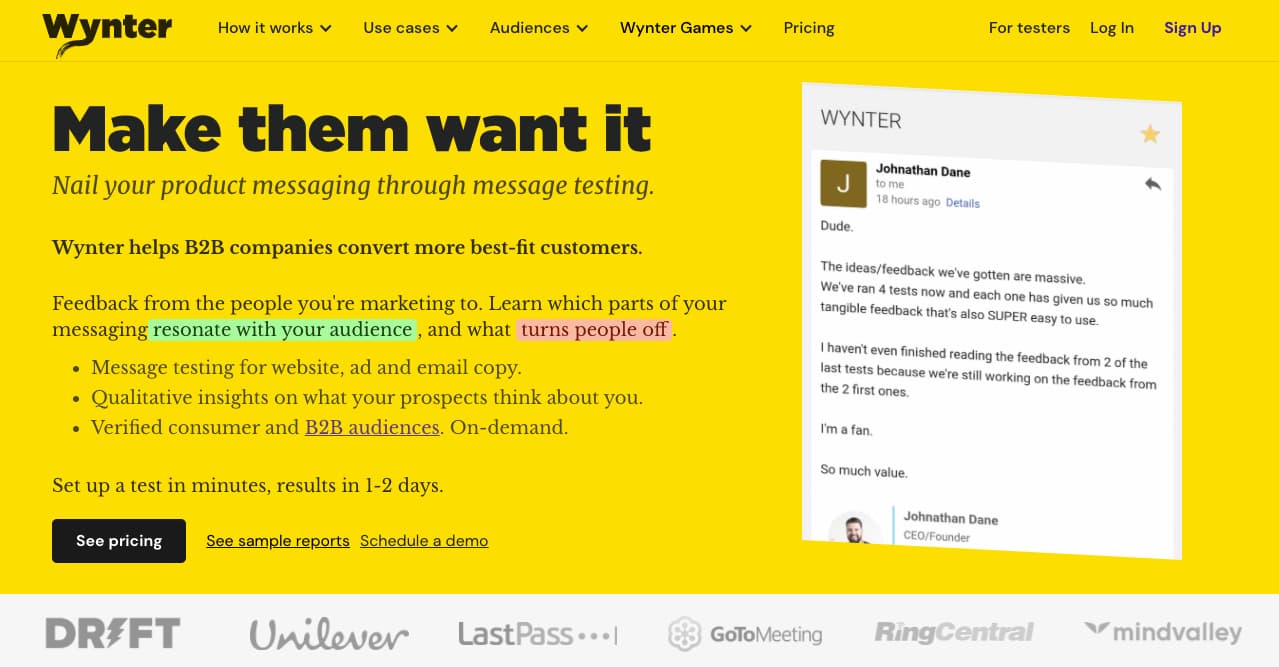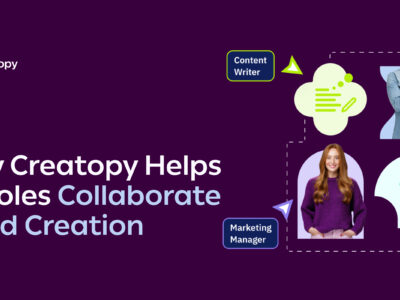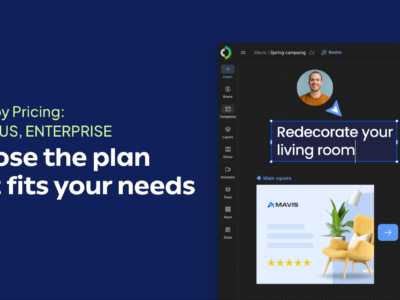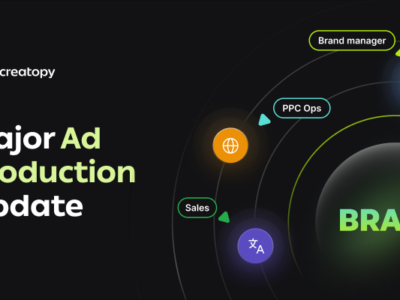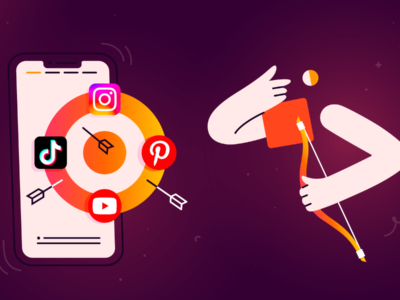We are the product of a data-driven society.
Nowadays, it seems like you can’t escape number-crunching algorithms, no matter what side of business or industry you work in. From shopping to investments and dating, most of life’s decisions seem to revolve around some sort of quantifiable data.
But if today’s data-driven world has taught us one thing, it’s this: trusting your intuition has never been more important.
Your gut is your own body’s process of interpreting the information around you. And your intuition is the result of millions of data points sending you signals before your rational mind has a chance to explain them.
In branding, tapping into your intuitive intelligence means taking control of the narrative, making your own decisions, and taking responsibility for them.
More than 40% of CEOs say they still make decisions based on intuition, despite having access to troves of hard data. I have a feeling that today’s guest of the Drag & Drop show is one of them.
Peep Laja has always been comfortable with change. He started CXL Agency, formerly Conversion XL, 10 years ago and turned it into a leader among conversion optimization companies. Then, he added the CXL Institute as an extension and finally shifted to focusing on Customer Experience Optimization with Speero in 2021.
In early 2020, Peep launched a startup called CopyTesting, using his experience to cover a big gap in the market. Six months later, they decided to do a rebrand.
In this episode, we unpack how and why CopyTesting evolved into Wynter.io so early in its development. We’ll cover how customer development plays a fundamental role in rebrands and what can happen if you don’t take control of your brand narrative. You’re going to want to take notes!
Introducing Peep Laja
Peep Laja is one of the world’s most respected specialists in optimization. His bold choices, strong voice, and experience have defined him as a champion of everything CRO, as well as all the disciplines that are connected to it, in marketing and beyond.
Peep is no stranger to making the difficult decisions that others often avoid. The sort of decisions that have allowed him to build (and rule) a conversion empire based on specialization.
Nowadays, he’s shifting focus to building new businesses from the ground up, serving as a founder and his own angel investor.
Stuff I Was Curious to Find Out:
- What triggered the need and decision to rebrand CopyTesting so early in the company’s development (02:17)
- How their approach went from niche to more general, instead of the other way around (11:46)
- What makes a brand name great and how they decided on Wynter.io (13:36)
- How Peep’s extensive experience in the CRO field impacted the rebranding process (17:54)
- What the CopyTesting rebrand meant in terms of standing up and challenging the status quo (22:00)
- How customer development interviews altered what the rebrand meant to them, in terms of changing vs. elevating their story (28:00)
- How they balanced their strategic view with what people were first inclined to think about the brand (30:11)
- Who the actual architects of change were and how they were involved in the rebranding process (35:42)
- The reactions the rebrand generated, both from existing customers and prospects, as well as industry peers (38:17)
- The ways this particular rebrand was different from the CXL Agency one (42:58)
- What main principles of a rebrand came to light during their experience (47:33)
- One highly valuable read for anyone considering a rebranding (48:54)
What You Can Learn From This Episode:
- How a mismatch in positioning, target audience and name led CopyTesting to figure out they weren’t in the business of copy testing at all (02:33)
- The value in getting the brand’s name right, even if it’s not right from the start (06:02)
- How Wynter.io found their best customers by actually listening to existing ones (06:47)
- The way name science can contribute to a business’s long-term goals in terms of investors and funding (14:12)
- Why qualitative research and an experimental mindset are key to early-stage startups (14:12)
- The influence of copy and why you shouldn’t blow all your branding budget on visuals (23:45)
- How to take control of the narrative and why changing your customers’ minds is much more difficult than planting an idea in their heads (31:10)
- How cognitive disfluency helps customers take pause and really consider your brand (33:16)
- The way challenging perceptions can contribute to and elevate your rebrand process (34:29)
- How to move fast without relenting on strategy in your rebrand (42:20)
- Why line extensions typically fail, even for established brands (43:21)
Key Takeaways:
1. Trusting your intuition is the best business tool you have
When starting or branding a new company, it’s easy to find yourself in a situation that falls short of your ideal vision of a great brand, creating a sort of void. It’s moments like these when you should rely on your intuition.
Trusting when your gut tells you it’s time for a rebrand allows you to take control of the narrative, turning the brand you have into the one you want. Still, it can be a scary transition, given our cultural bias towards empirical data, especially early on in the company’s development.
Remember that moving fast doesn’t necessarily mean forgoing strategic thinking. Don’t be afraid to make bold, well-informed choices just because you feel you’re on a certain timeline.
If you’re one of the lucky ones, rebranding can help you rise above the excuses and become the author of your own story, dreaming up possibilities and making attempts to turn them into reality.
2. Make hypotheses and don’t be afraid to change them
In the very beginning, every value proposition you come up with is going to be a hypothesis. One you need to test, gather research on and ultimately validate or invalidate.
One of the advantages of rebranding in your company’s earliest development stages is that people haven’t had time to grow as attached to the brand or to get the wrong idea about what you’re about. Changing preconceived notions is much more difficult than planting that idea in the first place.
Instead of focusing on the negative of having to switch directions, focus on solving real problems. Sometimes even solving the simplest, short-term problem can lead to a great brand positioning. The next time you find yourself in a brand strategy meeting or innovations session, work on finding the most compelling problem your brand can solve and then focus on it.
3. A rebrand is your chance to challenge the status quo
As marketers, it’s easy to find ourselves set in our ways, following the same long-standing practices of our forefathers. This “tried-and-tested” traditional way of doing things may yield some benefits. Still, our dedication to it in 2021 is surprising when we have so many other opportunities to gauge sentiment and really understand what people are doing with the things we put out there.
A rebrand is the perfect opportunity to challenge those perceptions on how you think a business should be run and really elevate what it means to build your brand.
The best way of doing that is so obvious, most people forget about it: talk to your customers. Study your product in its natural habitat, watch your customers using it and ask them questions. You’ll see that people do things in ways you’d never expect and find value in your product that you’d never be able to anticipate. This type of information is critical to the evolution of your product, brand, and overall marketing strategy.
Transcript:
Andra Zaharia: Peep Laja is a legendary marketer and community leader. He’s been championing optimization and experimentation for over a decade through CXL – formerly Conversion Excel – one of the most important and respected companies in the marketing space. Now, he’s using that experience to build businesses that cover big gaps in the market. In early 2020, Peep launched a startup called Copy Testing, bringing a much-needed service to the market. But soon after launching it, he realized he wasn’t getting the type of customers he initially targeted. In fact, Copy Testing was attracting a different category of clients with quite specific needs. Being comfortable with change and a proponent of bold, well-informed decisions, Peep chose to do a rebrand within six months of the launch. In this episode, we unpack the rebrand that transformed Copy Testing into Wynter.io – and the choices behind it. We explore how doing a rebrand earlier in the development of a business can save you a lot of wasted effort. We also cover how customer development plays a fundamental role in rebrands and why you should give people the chance to put your brand in a box. We also talk about the risk of not taking control of your brand narrative and letting others fill in the blanks for you. Plus, why brand extensions almost never work. You’re gonna want to take notes. It’s Andra Zaharia here, bringing you the latest episode of the Drag & Drop show from Creatopy.
Andra Zaharia: Peep, awesome to have you on the Drag & Drop show. I’m really excited to dig into the Copy Testing – Wynter rebrand, and kind of unpack what happened there because you move so incredibly fast in a market that also moves fast but I feel like your speed is, you know, three to 10 times faster than most players in this space. So I’m very curious about your thinking, your process, and everything that goes into that.
Peep Laja: Yeah, happy, happy to share all about it. So, where should we start?
Andra Zaharia: Let’s start with the decision. So, you decided to rebrand Copy Testing fairly early in the history of the company itself. So, what prompted that decision? You know, what triggered that decision?
Peep Laja: Totally, yeah. So, we launched the company as Copy Testing in May 2020, and rebranded it as Wynter in December of the same year – so, almost half a year later. And the thought that we should probably do that already, you know, was happening for multiple months. And it’s a big thing to change the name of your company – if you think about the brand awareness that we had built up to that point, are we going to lose that and the SEO stuff? And so, there were many reasons to hesitate but also, then, I was thinking, well, it’s gonna be much easier to do it now early on, rather than three years from now when the change is harder. But then if you look at some historical big renames, people forget. You know, like, Mozz and SEO Mozz – all the backlash when that happened, it was, “Oh, my God, like, everybody knows you.” Like, now, nobody remembers, you know, nobody cares. So that was encouraging for me.
Peep Laja: Why we rebranded? So, there are multiple reasons there. Let’s start from the top. So, when we chose the name Copy Testing, at first I thought – it’s kind of like usertesting.com. That was kind of the inspiration – that copy testing as a thing to do is just very new. I mean, it’s been around actually from the ‘60s, but it’s not mainstream. It’s very niche. So, the idea that we’re going to make this mainstream and we’re going to be the tool for copy testing was attractive – it was going to be like the Kleenex of that. That equivalent. That was the initial idea and then we thought also that we are in the business of helping you write better copy. That was what we thought the business we were in and we thought we’re going to sell to copywriters who are all going to use it in their copy work because it’s obviously great, useful for them. And so, we launched copytesting.com and the name is very clear. Everybody got instantly what we did and all that stuff. It was great early on. Then cracks started to emerge.
Peep Laja: So, any strategy you have is a hypothesis of what’s going to work. You’re always operating with limited data, so you’re making the best decisions you can. And you’re also running a lot of guesses or assumptions. And some of those need more data before you validate whether those assumptions are true or not. In our case, the assumptions we had made, didn’t pan out. In fact, we were quite wrong about them. So, we learned that we are not in the business of writing copy, actually; we are actually in the business of delivering audiences, putting companies, or whatever they produce in front of the audience that they’re trying to sell to. That’s actually the business we’re in. And copy testing as a use case is great, but we’re going to add more use cases down the line.
Peep Laja: Another thing that emerged was that we discovered so many other things, how we can use the panels that we have – the research panels – and so the name Copy Testing became limiting because Copy Testing says what you do, and it kind of makes you monofunctional because you don’t expect that usertesting.com also does, you know, a bunch of other things. I mean, it might, but I mean, in fact, now they do, I think, card sorting and all kinds of stuff – which is kind of user testing. So they will never be other tools. The name can be limiting. So, in our case, I felt that’s going to limit our future potential because Copy Testing is way too niche, to begin with.
Peep Laja: The second mistake we did was the assumption that copywriters are the target audience was wrong. They don’t have money, they don’t want to spend money, and they also actually didn’t take to the tool. Because, and I quote, many copywriters say, “Oh, I don’t like the fact that somebody is able to now challenge my work. Somebody has data on if what I write is good or not. Because up to this point – before our tool came about – it was your opinion versus my opinion. You know, like, I can write copy and if you, the client, don’t like it, well, that’s your problem, because it’s clearly great. But now we have data, now it’s sucks, man!” and they didn’t actually like it. And then we saw that, who was liking it, who were intrigued by the idea, were the people higher up in the marketing organization – VP marketers, product marketers, you know, people like that; performance marketers. And a lot of them were like, “Oh, this is great. But can you do B2B?” Because also one of the assumptions we had was that this is perfect for consumer products, especially e-commerce. Like, e-commerce has a lot of product pages. You can optimize the copy in your hundreds of thousands of product pages, It turned out product marketers, the e-commerce, once they ship a product page, they never think about the copy again. Not a problem to solve. In B2B where they have high manual contract values, it’s a different ballgame.
Peep Laja: However, in marketing organizations, the heads of marketing don’t care about copy. Copy is delegated to junior people, it’s outsourced. It’s like the new intern, Johnny, let him do the copy. But what the marketing leadership is concerned about is brand perception – how we come across – differentiation, positioning, and also messaging. And so, if there is a hierarchy, like, first you have your positioning, like, what are you about, for whom, from which it comes the messaging with what are the three or five key messages that we’re sending out about ourselves. And then finally, it’s like, the actual lines of copy that we write. And so, it’s also like, we’re trying to sell to marketing a thing they don’t care about or they think is very tactical – you know, it’s like, “Who cares about the line of copy? I’m not going to spend thousands of dollars to figure out whether my button copy could be better.” And obviously, we didn’t feel that we’re in the business of fixing button copy. So there was a mismatch there. So, in a nutshell, who we were marketing to was a mismatch, and how we were marketing to – our positioning – was a mismatch. And also, the target, like B2C versus B2B. There were many things. And finally, the thing about literal descriptive names.
Peep Laja: And finally, the thing about literal descriptive names. So, Copy Testing is a literal name. We do copy testing. So if your website is called wesellmicrophones.com, I have a pretty good idea of what you sell. You sell microphones. But then, so does everybody else. Competition is tough out there. Like, right now we don’t have competition – direct competition – who does exactly what we do. But only for a short while. It’s a transient advantage that we’re the only ones doing this thing, the copycats will come. And so, a literal descriptive name is a handicap. It’s a weak brand name, yet the brand is your long-term best competitive advantage, one of the strongest moats you can have. And so, let’s say that we are an SEO company and we are called SEO Company. And then, they’re comparing us to all these SEO brands and we cannot have any… How do we even measure that we are being talked about if we’re called SEO Company? So, the same with Copy Testing. Copy testing is a methodology so we can’t build a brand – or I mean, we can but it’s going to be considerably harder; it’s an unnecessary handicap. Marketing is hard enough that our brand is a literal name, but also, you know, is monofunctional – all these other issues. And so, based on all these factors, like okay, we need a name change and let’s better do it now, when it’s still easier. Most people don’t know we exist. This is a startup – early-stage startup. And so, yeah, we decided to go, then, with Wynter as our name.
Andra Zaharia: Before we dive into those details, thank you for laying out kind of the foundation and giving us the context to understand where you’re coming from. I had a quick question around business strategy here because what I’ve seen in the market is that usually, companies start with a general approach, and then start focusing on a niche and start to narrow it down but you decided to go the other way around. Was that an intentional decision or was it just something that naturally evolved? Or did you think of optimizing that effort into the beginning, let’s start with something hyper-specific and then, you know, see what we can do from there?
Peep Laja: Well, the way I see it, we are super niche. We are very niche – you know, a tool for just messaging is as niche as it can get. But obviously, it could be, you know, messaging for healthcare startups. But like, the idea that you even need to do messaging testing it’s a pretty new idea. It’s not a well-established category. We’re not doing a category creation over here. But it’s like a sub-category creation. So, a lot of our marketing is also around that, “Hey, you should be doing message testing. It’s the thing to do. Just as you do heat maps or user testing or things like that, you should do message testing.” And so, our niche is that we are about this one thing that you do. Now, in terms of our internal marketing. I mean, we do now say if you also go to our site – we say it’s for B2B – we do have consumer panels, and we service e-commerce companies as well, still, but we are saying we are for B2B companies. And internally, we’re going after B2B SaaS and agencies as our core target audiences. So, I would say that it’s pretty niche.
Andra Zaharia: It definitely is. So, thanks for kind of clearing that up because it makes… I’m very glad that you mentioned that brand is a long-lasting value and that sort of emotional connection that it creates with the audience is one of the things that’s also the most difficult to build, but at the same time, one of the most, let’s say, future proof things that you can do for your own business. So, when you decided to go with this name, did you have anything particular in mind, or were you more driven to make it something that’s short and memorable, something that people can easily find online?
Peep Laja: Short and memorable, definitely – you know, we don’t want to have a hard-sounding name – easy to pronounce. Those were kind of like the guardrails. So short, easy to pronounce, and so on. And then, you know, there’s the marketing trend of – not a marketing trend, sorry – there’s kind of a brand trend that there’s a lot of human names. You know, Casper, or Suzy or all these various companies that have like a person’s name – Goldman Sachs built this new brand around a name, actually. Marcus, I think, is their brand. I might be wrong. But anyway, so, I started to think about it. And so, there’s quite a bit of name research we did, and there’s quite a bit of name science that is also out there. And so, basically, the research shows that the more simple and human-sounding the name, the greater the company’s success. And brands with short, easy-to-pronounce names are viewed more positively by investors and companies are getting basically more money. And the companies with shorter, easy-to-pronounce names were more able to boost their book-to-market ratios, and so on and so forth.
Peep Laja: And Wynter, the name we eventually went with, is also a person’s name. It’s not as common as Peter and so on, but if you google it, there’s millions of Wynters around. So, it’s also a name of a person. So it’s kind of an unexpected name. And by using this kind of a name, we’re less concerned with sounding corporate and serious and more human. And if you look at traditional B2B marketing, there’s so much boring dry jargon and we don’t want to be that especially being about messaging. We want to have a little fun with the name. And then, how I actually got the name Wynter, like, I hired a guy from Fiverr and said, “Hey, here’s a list of 10,000 human names that I took from some website. I want you to see which names of .com or .io are available or for sale at a reasonable price. And it came back and all .com were taken, which was interesting, and most 99% .io were also taken. For Wynter, .io was available and .com was for sale, meaning not in active use, there wasn’t a brand occupying it. And there was a pun with Wynter, like the season, and thought we can have fun with this, especially for the launch – Winter is coming from Game of Thrones type of stuff. And so, we went with Wynter. We liked the name. Also, the founders being from Estonia, a Nordic country, winter, cold kind of like resonated with us. And so, yeah, we went with it.
Andra Zaharia: Thanks for sharing this story. I like how you’re truly getting into the nitty-gritty of it and explaining everything you did step by step. I wanted just to roll back a little bit and talk about the methodology that you used to actually understand when it was time for a rebrand and what kind of brand you wanted to build going forward, kind of in the next stage of the development of your startup. So, you’re obviously one of the most respected specialists in optimization – and not just that, all the connected areas to it, because there’s so much that goes into CRO and all the disciplines that are connected to it, which is, well, almost everything that goes into marketing and beyond. So which elements of your experience were the most useful in this process? And what were the things that you looked at? I saw on LinkedIn that you mentioned that you talk to customers, and you often talk to almost all of them that you onboard onto Wynter. What are other tools in your toolbox that you used?
Peep Laja: Yeah, so qualitative research is a big one, especially when you’re an early-stage startup – and the quantitative data is harder to come by. You just don’t have meaningful sample sizes. So my experimentation optimization background is giving me the mentality that change is just a normal part of life. You know, I’m not resistant to change. If you have an experimenter’s mindset, there are no holy cows, everything is up for grabs. I am interested in signals that are telling me which direction to go to. So, obviously, you don’t just blindly follow whatever, you know, like, as they say, you can’t A/B test your way to success. You need to have vision, you need to have conviction, you need to have a point of view – which are all the things I have. But you still listen to the market and you see how it clicks. Another interesting data point was that when we rolled out and, as I said, like, I thought our market is B2C, meaning like, B2C companies – we’re B2B. But B2B companies were much happier with our service and they got it better and the test reorder rate, like the retention and the lifetime value, all those things, like, that’s the direction we should head to. And also then, you know, obviously realized things like, they have money and budget and power. But we have a positioning conflict here. So, yeah, me being used to running a lot of experiments definitely helps and a lot of qualitative research. I’m doing all the demos myself, still, right now as a founder. On average, I do like five, six demos a day. In fact, before our talk here, I just finished two demos and I have two more after this chat.
Andra Zaharia: That’s fantastic and it sounds very intense at the same time. But I definitely understand the value of talking to customers. Working with startups for such a long time, I know that this is one of the most valuable things you can do, especially as a marketer, or a content creator. No matter what your role is, if you’re somewhere in the communication field, you have to talk to people, you have to understand what they’re thinking and challenge those perceptions. And this is kind of your bread and butter and I love that you mentioned that copywriters didn’t get the service or felt that resistance to it simply because they’re not used to someone challenging their work with data in this manner and I think I welcome this type of service into the market. I think we definitely need it and I’m really looking forward to seeing how it evolves and how it challenges people to level up and not just go on their personal preferences, which is such a big issue in design and content.
Peep Laja: Right. And I want to clarify that I’m generalizing here. Obviously, there have been a number of copywriters who are all in and who are actively using it so…
Andra Zaharia: Of course, of course.
Peep Laja: You know, I love copywriters, but like, to my surprise, a large chunk of them were resistant. Yeah.
Andra Zaharia: Yes, definitely. We feel like even if you’ve worked in a startup format, or kind of embody this way of doing things, we’re used to everything that you said, you know, dealing with change, moving quite fast, putting things out there before they’re perfect so you can figure out if they actually work or not – all of these things. But, you know, talking to you and so many others still brings this up to the surface, that it’s not a generalized thing, there’s so much resistance, there are so many mentalities and stereotypes that keep going forward along with the other changes that are happening. So, when someone challenges the status quo, it’s definitely something that helps the entire community and the industry evolve. And I feel like you’ve been doing this for a long time, you’ve been challenging the status quo for a long time. And you actually mentioned in a post a short while ago that, you know, picking a fight is good for marketing, standing for something is good for the brand, and you need to repulse them and attract others. And that turning away some of the market is scary. So I want to unpack this a little bit so you can give us kind of your perspective on this. So what are you fighting against? You know, you picked a fight with the status quo with Wynter.
Peep Laja: Typically with Neil Patel, but yeah, also the status quo.
Andra Zaharia: So we’re talking about kind of dodgy, you know, marketing practices, about things that are taken as such and not questioned? Am I kind of giving listeners who maybe you don’t know who Neil Patel is because we might have some, you know, designers and other creatives that haven’t come across his…
Peep Laja: Yeah. Well, I mean, I don’t want to really talk about him. But yeah, that’s an ongoing little feud, just for fun, for the most part. But with Wynter, yeah, our enemy here is the status quo, which is people are not testing their messaging. They’re just going to market. Somebody wrote a line of copy that he said, like, “Oh, these are the five reasons to make business with us, to buy from us.” These are the five key benefits or whatever your value proposition consists of. But like, do they care about those? Which one do they care about the most? What actually resonates or doesn’t? And imagine if you’re spending thousands of dollars a month on messaging that doesn’t work as well as it could, like it’s just a massive waste. And so, currently, I’m mainly fighting this. Copy matters – and in fact, there’s hard data that says that copy is the most influential part of getting people to convert, it’s the most influential aspect. Twice as influential is copy. So I’m fighting that mindset that people think that it’s okay to spend hundreds of thousands of dollars on a visual rebrand and then we get a copywriter and pay them 500 bucks, check, done – while copy provides more money, ROI, than design. So that is kind of the fight that I’m fighting here.
Andra Zaharia: Cool. So you’re definitely for the people who get this, the people who know that this is an important aspect, and the people who are willing to have their work tested and challenged, no matter if they’re marketing directors or someone that’s specifically focused on copy. I was very curious, did you test your own copy before launching the Wynter rebrand?
Peep Laja: Yeah. So, yes and no. So we built the company because we wanted to test our messaging and there was no way to do it. You know, it was like, at my other company CXL, we have some 60 different long form sales pages for our courses, and then PPC landing pages, webinar landing pages, all that. And the way to increase the conversion rate on those pages is to improve the copy and I didn’t know what was wrong with the copy. There was no tool that could tell me, which led me to build Wynter. For ourselves, it’s kind of tricky doing message testing for ourselves because the people on our panel – because we have our own panel, this is another topic. It’s like, there’s a company offering your panels, panel providers. It’s a big scam, we didn’t know that it’s a massive ripoff. Like, we didn’t want to build our own panel. We thought we’re gonna use one of those third-party platforms. It’s such rubbish. Anyway, I digress. So we built our own panel. Now, all these people on our panel, they already know about us. They filled out forms to be on our panel. So when we say, “Hey, what do you think about this?” there’s a little bias in there. They not looking at it with a fresh pair of eyes. I mean, it’s still useful and so, we have done it. So when we had a consumer panel, we tested our messaging when we were still Copy Testing on a consumer panel, like, this is like the regular people on the street. And people didn’t even know what copy is. You know, like, what are you talking about here? Oh, this is not a mass product, like this is definitely for the niche. That’s an interesting thing about jargon or buzzwords is like, yes, the regular person on the street doesn’t know what copy is. But also, I’m not going to not use that word when I’m talking to my actual target audience because they get it. You know, there’s some jargon that’s actually needed.
Andra Zaharia: Yeah. That makes perfect sense. I was curious about something because this bias makes it difficult to use your own kind of – eating your own dog food, but it’s in a different format. So, you’re definitely offsetting, let’s say, some of that risk, I guess, by doing all of these customer interviews and doing very intense customer development, which is obviously super, super important. So, you expanded the brand, you didn’t necessarily change the story that you were telling – you just elevated it to a more strategic level, let’s call it that. Would you say that?
Peep Laja: Exactly. So instead of copy, we now talk about messaging, just short of positioning. It’s like, positioning is more and more involved in strategy, like, I don’t think like a SaaS tool can tell you what your positioning should be. So that’s not the business we’re in. But we can tell you how it comes across, you know, which is really, really important. So it’s tied to positioning because positioning has to tell the target audience, how we are the best for your type of user, your type of company for this use case – why we’re the best for that. And a lot of positioning testing is done in sales meetings, which is great, but it’s very slow and doesn’t scale and people are busy. And, you know, I’ve been talking about the importance of user research and interviews for the last decade. It’s starting to go more mainstream, I think – qualitative research, user research – but it’s so time-consuming. So that is another problem that we’re solving. It’s like, we give you data like that. Yeah. It’s not as good as the interview where you can ask follow-up questions and there’s an actual conversation but it costs way less and it’s done for you right away, you know.
Andra Zaharia: And it’s more scalable in that way as well. Because doing it in-house can really add pressure to the team and delay all of the other things as well. A note about positioning and the strategic perspective: at some point, you posted that people want to put you in a box and you should let them. And I feel like when you try internally to do a rebrand or kind of shape the next stage of the company – because that’s usually what a rebrand does – it either reflects an evolution or it just takes the company to the next level. How do you balance your strategic view, that you want to put out there with the box people want to put you in? Because I feel that’s a difficult balance to achieve. You know, people tend to go one way or the other, or just tilt the balance in favor.
Peep Laja: Well, if you are not making it super clear which box to put you in, you’re going to let people decide – and that’s when you lose control of the narrative. And that’s dangerous. Because they might put you in the wrong box, they get a wrong idea of who you are for what you’re about, and then changing these preconceived notions or ideas is much more difficult than planting that first idea at the start. So, a classic example of this is Segway. You know, when the product launch campaign was happening, the founder refused to describe what it is. He just said, “This is going to revolutionize transportation.” “Oh, what is it? What is it? What is it?” “I can’t say. It cannot be described.” You know? So what are people thinking? They’re going to make up their own story. They’re going to fill in the blanks. And they’re thinking “Oh, flying cars. Finally, we’re getting flying cars.” And then when they do the product launch, finally, live TV and the founder rolled to the stage with Segway, people were like, ”The fuck is this?”
Andra Zaharia: Disappointment.
Peep Laja: Disappointment. And he still refused to define what it is. And yet, now, electric scooters are ubiquitous around downtowns all over the world. And they came and said, “Hey, these are electric scooters. Ride them around the city? Makes sense.” You know, so they put themselves in a box and I think you should let people. Just today I was doing a demo with a company and they said scaling agile – we’re helping you scale agile. What do you think they do?
Andra Zaharia: They’re either in software. I would say that they’re in software, and they teach agile for organizations, but it’s uncertain.
Peep Laja: Yeah, you’re not too far off. Yeah. But I mean, it’s helping you manage holacracy in decentralized organizations, but basically, I was looking at how they described it. I want to figure out, what are you? Are you like a CRM? Are you a project management tool? Like, what are you? I’m trying to… Actually, I do feel that making it a little bit hard – so basically, the cognitive disfluency is beneficial. Because, you know, thinking fast and slow, obviously, normally, we’re just thinking automatically. And if they said, “Oh, I’m a CRM” I even don’t read up, like “Oh, CRM, you know, I already have one of those. Not pausing to think.” So if you make it a little bit harder to figure out, people are actually going to stop and use the slow thinking part of their brain. So, some cognitive disfluency is good. There’s a fine balance, obviously and it’s not an exact science. So you can go easily the other way where it’s unclear and they just don’t get it. And if they don’t get it, they don’t buy it. Which is again, why message testing is important.
Andra Zaharia: Absolutely. It builds awareness, ultimately. I think that self-awareness is something that supports rebrands, branding in general, brand building, building copy – building the entire business and building ourselves as people who have businesses and build businesses or contribute to them in any way or form. And we come from such a long tradition of doing marketing and all the other disciplines – PR as well – you know, doing the traditional way it’s surprising how long-standing these practices are, and that we’re still doing them in 2021, when we have so many other opportunities to gauge sentiment and to really understand what people are thinking and doing with the things that we put out there. So again, I think that a rebrand is a good opportunity to challenge those perceptions, to challenge what you think about your business, and to really elevate that, and go really pro on what it means to build your brand and business going further. In terms of who architected this change and this rebrand – you know, it was obviously yourself – which other members of the team were engaged in this process? And how did you delegate ownership of several aspects of it?
Peep Laja: Well, it was led by me and championed by me. And so, in that sense, like, I did check in with my sounding board, my product manager. I have my other shareholders, like my co-founders that are more passive. So, I used them as a sounding board, like, “What do you think?” And mostly, it was positive. I mean, I’m a pretty strong personality, and I can easily come at you with a lot of force, and usually, I get my way. But people are also used to me having… I have a history of having made the right decisions, which are scary at first. I changed what CXL was about when people were like… When we changed from an all-purpose agent to a corporate version of agency, people were very resistant. Like, I’ve had many of these cases where I said, “Stop everything, we’re going to go that way now.” And these big bets have all paid off. So I’ve built up some goodwill, let’s say, that people are trusting my intuition or my synthesis of the situation.
Andra Zaharia: Definitely. And you can see that strong voice of yours, not only how it’s reflected in the community, but I feel that it also reflects into the brand because you’re creating so much content around Wynter. And it’s having an increasingly clear and a very articulate voice – of course, first through you, because we’re all watching you. And then the brand itself when it’s going to outgrow, let’s say, your leadership in a good way.
Peep Laja: Yeah, well, I mean, this is a self-funded – or customer-funded – company, we haven’t raised any money. So I can’t throw a bunch of money on ads, and whatever. So, social media marketing plays an important role.
Andra Zaharia: It definitely does. And it’s also helpful in the way that, you know, you can see how the brand is received. And speaking about that, what kind of reactions did you get? Like, “Hey, why did you change the name so soon after launching the company? And what’s this about?”
Peep Laja: Yeah. The reactions were like, “Oh, Copy Testing was so clear. I liked it.” Which is like, “Yeah, it was clear. I agree with you, man. I also liked it.” But people don’t know the context. They don’t know. So also, they say, “Why did you choose a name that doesn’t mean anything?” You know, it’s a common objection I hear. Not a lot, but it comes up. Like, this was a conscious decision on my part to pick a name that doesn’t mean anything. You know, it’s one of your Google’s, you know, like, has no preconceived notions about it and it can be anything, it can become anything. It really leaves it open.
Andra Zaharia: It does. It definitely does. And was there any backlash, I guess? Although it’s a strong word. I don’t think that people had the time to grow as attached to the brand to really become very negative about the change. But what was the impression of the customers when you launched it? Because obviously, there were customers who made that transition?
Peep Laja: I mean, no real pushback. I mean, most people said nothing at all, which is your standard, right? It is like, no response. And the people who when we announced to the email list, “Oh, by the way, your account is now on Wynter, not Copy Testing and nothing changes for you” the people who did respond, most people liked the new positioning, and that’s actually the word they use because now we are like message optimization and message testing for B2B, which is the new positioning and they’re like, “Yes, I’m digging that.” So that was encouraging. Also, I’m really used to not… I’ve never been managing through consensus. You know, that’s not my style, really. I’m more like a benevolent dictator type.
Andra Zaharia: You’re definitely bold in your approach and this has been true for a number of years. And I believe it’s also one of the factors why you have such a large following and you’ve made such a great impact on the community. In terms of, let’s say, breaking points that appear when doing a rebrand – you know the podcast audience is made of creatives of all types. And we’re talking about rebrand. So we’ve talked about, you know, the process of doing the visual side of things and aligning people internally, cascading that towards customers. But what about the more technical aspects which you have such a stronghold of, you know, in terms of SEO, migrating stuff? How difficult was that? Although you didn’t have 10 years’ worth of content and pages to migrate.
Peep Laja: Yeah. Well, I mean, we relatively recently did a domain name change for CXL when we went from conversionexcel.com to cxl.com. And that is a very high traffic website. And then, we recovered our rankings within three months there. So I wasn’t concerned about it. I mean, technically is pretty straightforward, right? Like, you 301 all your domains, and bam, you know, it’s Google, Google, Search Console updates, and we changed the link wherever possible. So it’s not very technical, it was seamless. And then in Wynter’s case, our domain authority at this point is so low that I didn’t even check our rankings. I know, over time, it’ll be fine. You know, like, we can’t rank push it anyway, right now.
Andra Zaharia: Not yet. Not yet, definitely. So I love this idea that you decided so early on and that you went with the change and that you didn’t wait for five years before you were sure that this is what he wanted to do. I love this fast approach that’s also strategic because moving fast does not necessarily involve breaking things as the saying goes, which has become too much of an accepted truth, although it is not. You can be fast and strategic at the same time. And I love how your example illustrates this very well. And what I also wanted to ask was a little bit about another rebrand that you did that has a different approach to it, which is spinning off CXL agency into a new brand called Speero. So given that, that’s a different approach, could you share with us what the thought process behind that was?
Peep Laja: Right. So I started CXL as an agency and then many years later – maybe five years after starting it – I added on CXL Institute, back then Conversion Excel Institute, as a brand line extension. So it was like, we were looking for other ways to monetize the community, we had the email list, and so on and so forth. And it seemed like it’s easier if we used the same brand and just it’s another product of CXL. Back then – this was 2016 – I was a little uneducated about matters like brand extensions, and the fact that they fail most of the time. Since then, I have read countless books on the topic and there’s a reason why Unilever and P&G have their own separate brands for the soap and the dish soap and whatever. It’s all separate brands on purpose, because line extensions typically fail because it’s very hard to stand for two ideas at the same time with the same name. Like, back when cigarettes were still a thing, when Marlboro introduced Marlboro Light the whole brand crumbled. Like, it used to be the tough guy, the Marlboro countryman, and then suddenly there’s Marlboro Light, like, what is it even about anymore? So already in the ‘80s, people knew about this, don’t do it. I didn’t know it. Then I regretted it later. I was too late to correct it. So this is a story of waiting too long. And so, it became an increasingly big problem for us. Are we an e-learning company? Are we an agency? And some people knew one side and didn’t know the other side. What are we? And behind the scenes, we also had separate teams, separate legal entities. And then, it was like, who pays for what? And if we wanted to raise money for one of the entities or sell off one of the entities, nobody wanted both, because they’re separate businesses. You know, like you either want agency or like… Just too much confusion on the inside and on the outside. And so, we decided to make them into separate brands. The internal debate, obviously, was which one is going to be a new name? The agency or the Institute? And we decided that with all the assets that we have, the trip blog traffic, the email list, and so on, those make more sense for the e-learning business because it’s a lower price point, and etc. And then the agency is more referral business anyway because it’s very expensive. And so, new brand for the agency, new direction as well, and now it’s Speero and CXL Institute is just CXL now.
Andra Zaharia: That’s super, super helpful. And I love the fact that you mentioned brand extensions because it’s something that I don’t think we realize even as marketers until we are actually confronted with the choice or you have to look in retrospect and analyze, you know, what’s happened and why things aren’t working. I think that generally as humans, we crave clarity so much, and focus. And it’s so difficult for us, especially now, especially when we’re, you know, I’m gonna repeat the same cliche, but we’re drinking from a firehose of information, sometimes we have difficulty thinking straight. We’ve all had a past rough year, it’s not easy now. It’s not like 2021 changed everything. So I feel like giving customers clarity and giving them reliability and not creating extra cognitive effort for them, except for that little bit that makes a difference and gets them to pay attention. I think that it is an essential principle to follow in business, in positioning, in branding, and so on. So, just to wrap up, you’ve given us so much to work with and to think about, but I want to go just a little bit deeper into your mindset and ask you, what do you think the main principles are to follow or the main questions you use when you’re looking to do a rebrand or you’re considering, you know, engaging in one?
Peep Laja: It’d be easier to stay with the name that you already have. So I would encourage you to be definitely sure that you’re actually solving actual problems. Like, what are the problems? And sometimes we get tired of marketing our own stuff, and it would sound new and exciting to have a new name and a new design but there is a potential that it goes wrong, you know, there’s clarity issues and so on. However, if you have the data that yes, I mean, absolutely, the current name has a number of problems – sameness problems maybe or whatever it is – you have just an unpronounceable name, like marketizater – one of the monster names from the past – then I would just go ahead and do it. I bet two years after you change your name, nobody will remember the first one.
Andra Zaharia: That is so, so true. You mentioned that you read a number of books that you found very helpful in understanding branding and brand extensions and the whole dynamic of the field. Could you recommend a few that really stood out for you as highly valuable reads?
Peep Laja: Oh, well, one is the classic The 22 Immutable Laws of Marketing. One of the laws is like, “Don’t do it.”
Andra Zaharia: Definitely. So, thank you so, so much Peep for everything that you’ve shared today, for all of the details, for being so straightforward about it. You’ve lifted the community so many times with sharing your trajectory and your decisions. So, I definitely think that this is going to be such a welcomed and necessary addition to what it takes to do a rebrand well, and when to do it, especially for startups who are sometimes not as well-versed or experienced at branding things because obviously, hence the nature of a startup, but this is going to be a great resource for them to dig into and really help them make better decisions that hopefully they won’t regret too much later.
Peep Laja: Thank you very much.
Andra Zaharia: Thanks for exploring another fascinating rebranding process with us. If you found it helpful, subscribe to the show in your favorite podcast app and leave us a review. Until next time, this is Andra Zaharia. Thanks for listening to the Drag & Drop show by Creatopy.
Connect With Peep:
Resources Mentioned in the Episode:
- Speero launch announcement
- Article – Moz SEO Software rebranding
- Article – Kleenex – How a brand name becomes generic
- Website – Goldman Sachs
- Website – Fiverr
- Game of Thrones – Winter is Coming
- Website – Segway
- Article – “People want to put you in a box…. and you should let them.”
- Google Search Console
- Website – Malboro brand
- Goodreads – The 22 Immutable Laws of Marketing: Violate Them at Your Own Risk, by Al Ries, Jack Trout
Thanks For Tuning In
The Drag & Drop Show is an original series created by Creatopy.
Click here to give Creatopy a spin.
If you liked this episode, hit “Subscribe” to get notified of the latest episodes wherever you get your podcasts:
